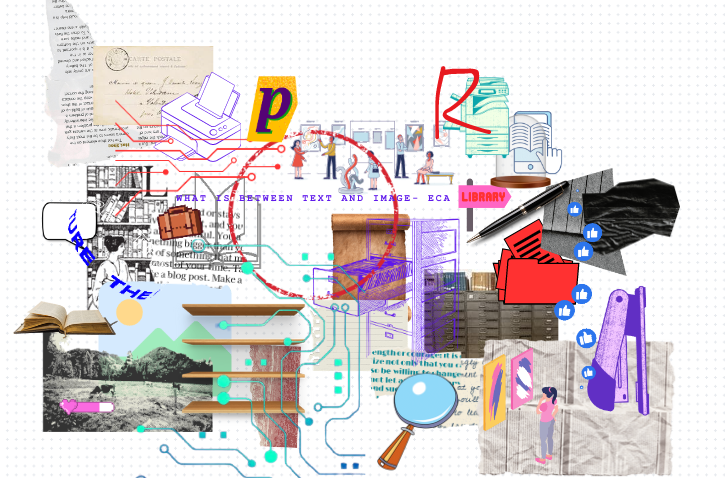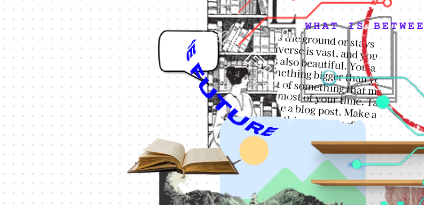When I had my idea set out for the theme of text and image, I attended multiple shows at the Sculpture Court, ECA. I sought out text-based artworks and artist books at these shows and was very happy to see such a range by practice students. The first artists I contacted were Alysse Lee-Orr, Ffion Williams and Nishi Chodimella, all fourth-year students on the Fine Art (painting) course who had displayed text in interesting ways. Nishi, who created prints on handmade paper, had to pull out early on in the project so I continued to look for other artists that may be appropriate for the exhibition. As I was attending these shows mid to late March, most students were very busy with deadlines at this time, meaning some communication fell through but this picked up in early April. Around this time I had heard back from MA Creative Writing students after I had sent an email with a proposal to Alan Gillis, Professor of Creative Writing at Edinburgh University; it was great there was interest here and made the themes of text and image more interesting. Communication was different for the creative writing students as exhibitions are not a main focus of study but we had multiple meetings in the library space to discuss ideas and development of the project.

Whiteboard of beginnings of ideas of situating artworks within a library context.
Artist/Poet bio’s:
Ffion Williams
Text and voice are powerful but can also be drowned out, and when language is not taught how could it be understood? My work uses text and the Welsh Language (Cymraeg) to explore themes of Welshness, protest and hope. When using welsh I make mistakes and substitute English. I call this Cymraeg Ddrwg (bad welsh). Through this, I embrace language as an evolving tool for creation. The layering of different mediums distances it further from legibility.I conducted interviews at the train station in my home town. My installations embody the commotion of a train station, with light and sound guiding the viewer through the work. Protest is a large part of Wales’ legacy. Through my metal sets and protest banner motifs, I strive to display the power of protest as a tool for change. Suppression of cultures through colonisation has been experienced in many different contexts. My work goes beyond my experience, sharing stories on a wider scale.
C.T. Hilton
I’m a poet based in Edinburgh, working with absurd and surreal imagery to create bizarre universes that challenge the habituation with which we engage with the world, and where anything can happen. I am interested in the sounds of certain words and phrases, and the emotions tied up in them. From here, my work moves in two distinct directions; to either evoke or ridicule. In the former, I hope to place the words and emotions in unfamiliar environments, so that we might engage with them anew, and savour the nuances within. In the latter, I aim to expose the contradictions between the words said, and the emotion driving the words – with particular emphasis on the saccharine or overtly sincere. I take particular umbrage with the idea that poetry must be exclusively sincere and serious – for me the joy of art and writing is to push an idea as far as it will go, taking myself and the reader on a journey to places we never thought we’d go.
Alice Eaves
I am a poet and visual artist based in Edinburgh. My practice currently focuses on finding innovative ways to connect visuals and text. This pursuit has led me to create experimental art films, collage poetry and immersive live performance. At the moment, I am exploring concrete poetry as a vehicle to sonically connect language and form on the page. I think making work that visually reflects the themes of the poem invites a new way of reading. Concrete poetry allows the writer to manipulate where the reader goes next. It can cause disruption, shifts and breaks but can also create flow and languidness depending on its desired effect. This interests me compared to traditional poetic forms (such as sonnets, sestinas etc) for it takes the reader on a visual journey through the white page instead of just seeing the page as a means to an end.
Alysse Lee-Orr
I am an interdisciplinary artist working across text, painting and collage. Central to my work is the belief that reality is constructed by interconnected imaginaries or fictions; narratives authored by those in power which shape the world around us. In my art practice, I work to destabilise these narratives, creating speculative fictions which explore themes of utopia, gender, the body, ecology, architecture, and community. I approach these themes using a process of collage, and my work often manifests as an assemblage of gathered text and images in space. Through a continued process of deconstructing and reconfiguring, my artworks are constantly changing, evolving, and in flux, shifting in and out of time and space, they slip between worlds and hurtle towards unmaking. I see them as sites of reworlding, spaces of reclamation, where we might imagine and realise a post-patriarchal society, a utopia, building architectures of possibility and constructing a world beyond the confines of the dominant imaginary.
Kinslee Sikes
I am an Idaho born poet that is currently based in Edinburgh. I enjoy using my writing to investigate and contextualize the feelings that are below surface level — the intangible emotions and aspirations we know are there but can’t quite put our fingers on. Through my work I hope to encourage readers to let their normal rationales unravel, and to embrace the unknowable. I am fascinated by unique perspectives, and always seek to present ideas in unconventional ways that encourage one to look at things from all sides through a lens that surrenders itself to feeling instead of rationalizing.



Leave a Reply